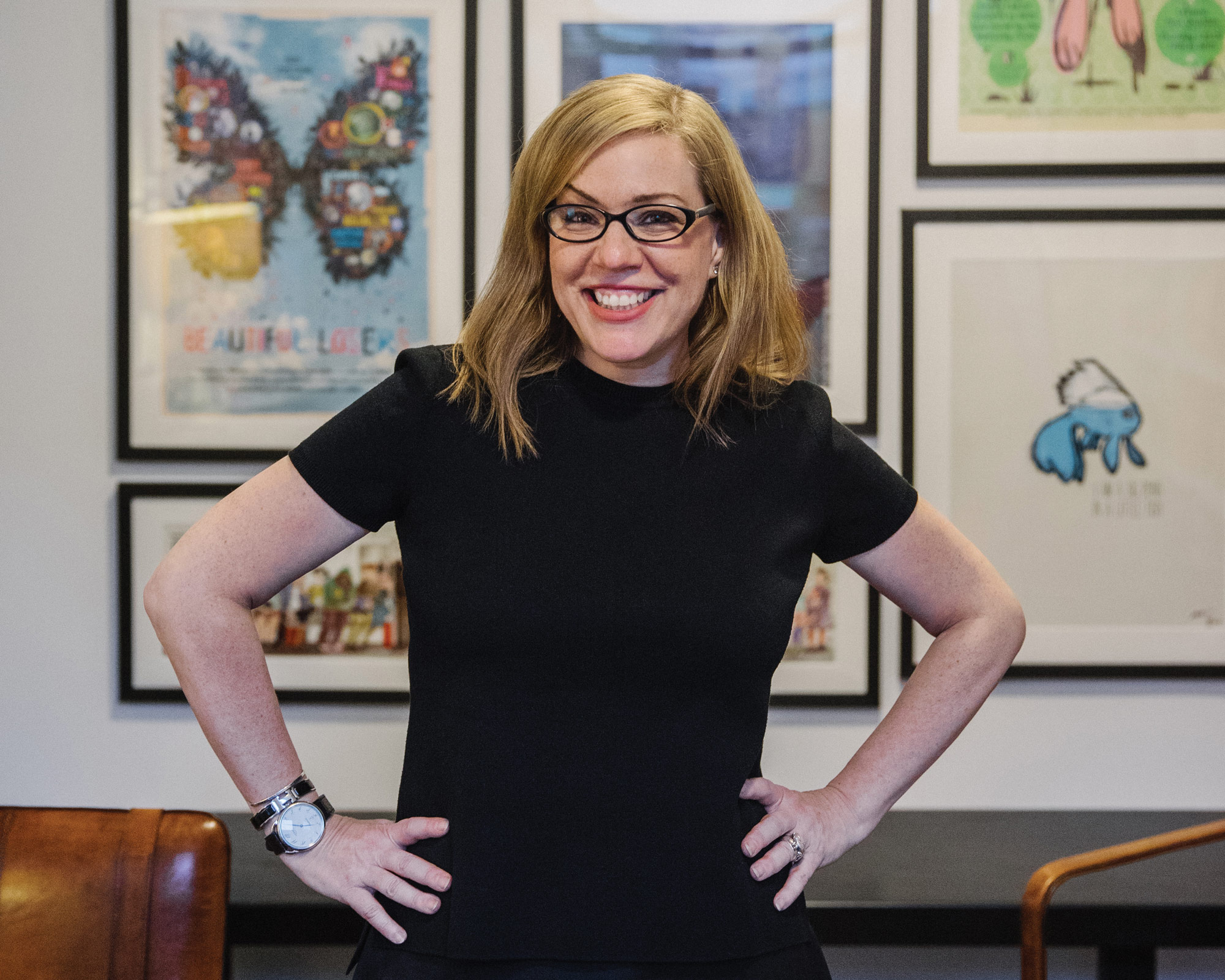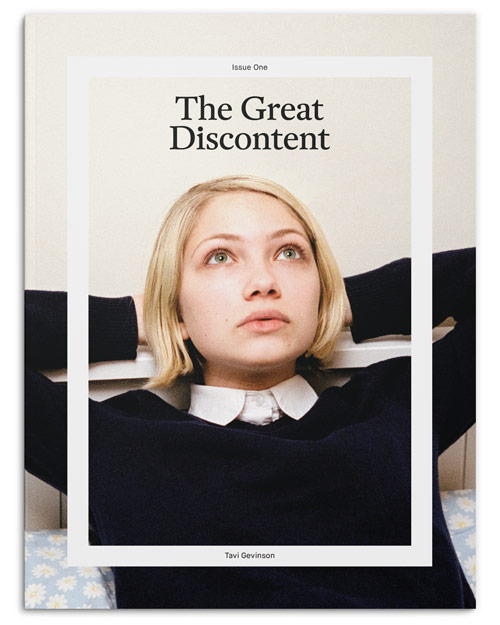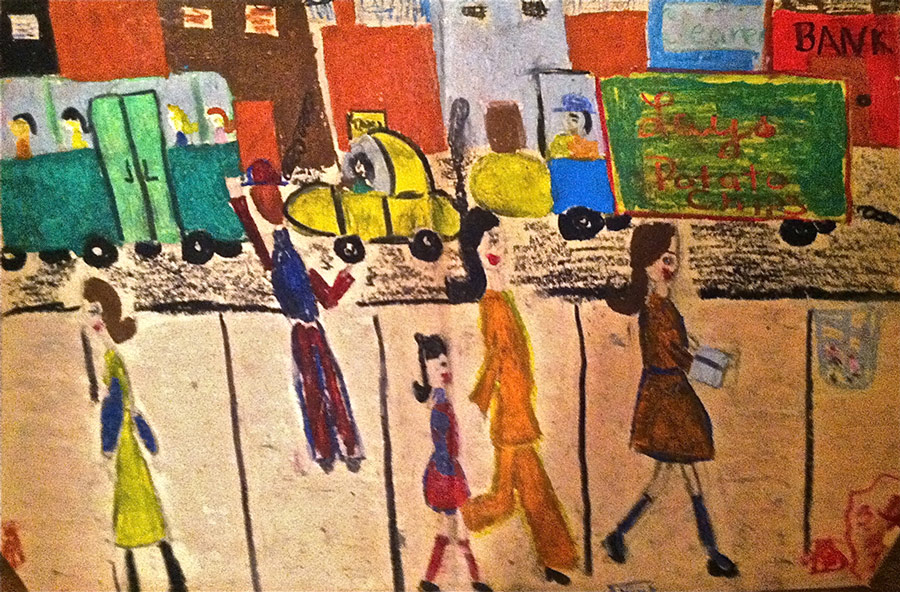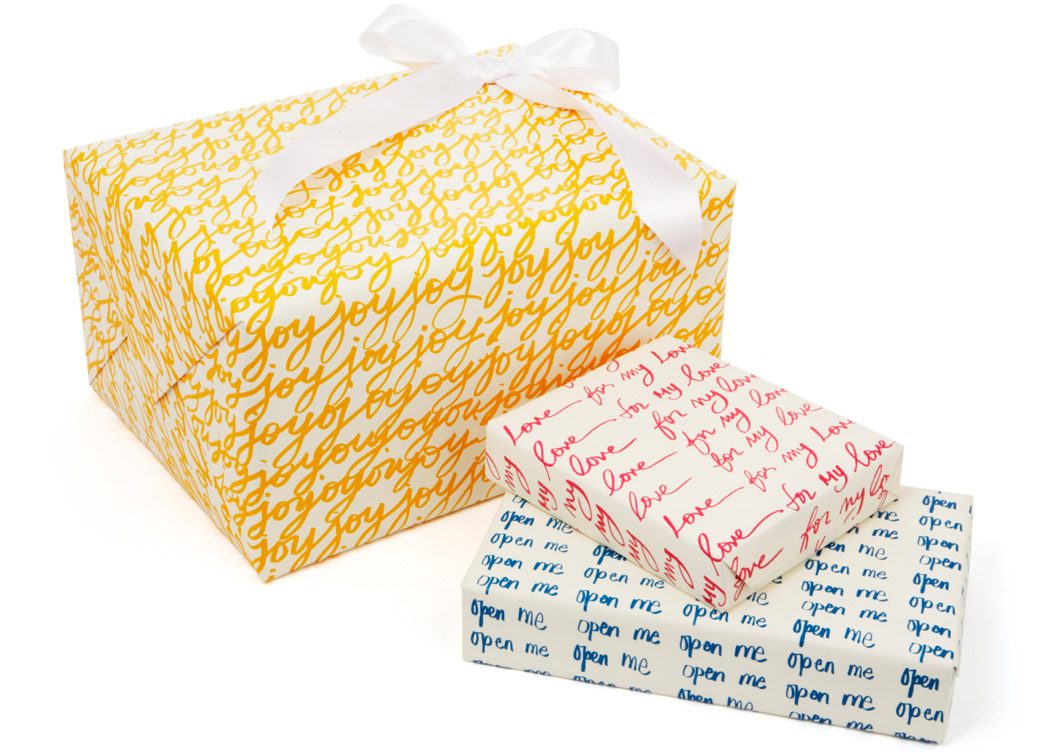
- Interview by Tina Essmaker January 22, 2013
- Photo by Ryan Essmaker
Debbie Millman
- artist
- broadcaster
- educator
- designer
- writer
Debbie Millman has worked in the design business for 30 years. She is President of the design division at Sterling Brands, President Emeritus of AIGA, and Chair of the Masters in Branding Program at the School of Visual Arts in New York City. In 2005, she began hosting Design Matters, the first weekly radio talk show about design on the Internet. She is the author of five books on design, including Brand Thinking and Other Noble Pursuits.
Interview
 Editor’s note: An updated version of this interview, including new images and work, is featured in print in The Great Discontent, Issue One, available in our online shop.
Editor’s note: An updated version of this interview, including new images and work, is featured in print in The Great Discontent, Issue One, available in our online shop.
Since you do a lot of different things, I’ll start by asking you what you’re currently doing.
I’ve always done a lot of different things, which is what I like. I’m currently President of the design division at Sterling Brands, Chair of the Masters in Branding Program at the School of Visual Arts, a contributing editor at Print Magazine, and I host the design podcast, Design Matters.
When do you sleep?
People always ask me this! Believe it or not, I’m a big sleeper and I like to get a minimum of seven hours a night. I think high-energy people need a lot of sleep to stay high-energy.
Would you describe your path to doing all the things you’re doing now? You can go as far back as you’d like.
That’s 30 years! Are you really sure you want to hear the whole story?
Of course. We want to give our readers a sense of how you got to where you are now.
Okay, get comfortable. I graduated college in 1983; this is my thirtieth year as a professional practitioner of design. My first ten years after college were experiments in rejection and despair. I knew that I wanted to do something special but, frankly, I didn’t have the guts to do anything special. When I graduated, I didn’t feel confident enough, optimistic enough, or hopeful enough to believe that I could get what I really wanted. I wasn’t living what I would consider to be my highest self—in fact, I was probably living my most fearful self.
My first job was creating rudimentary paste-up and layouts for a cable magazine—fairly old school stuff. After that, I worked as a designer for a real estate company, which was the worst job I’ve had in my career. I quit in despair after a year and started my own little business with a partner. This might have seemed like a fearless thing to do, but I wouldn’t say that the work we were doing warranted that description. It was the mid to late 1980s and back then, there was a big, powerful design scene happening in New York. I felt like I wasn’t contributing anything meaningful and was in awe of designers who I thought were indeed making a difference: Tibor Kalman, Emily Oberman, Steven Doyle, Bill Drenttel, and the folks at firms such as Doublespace and Manhattan Design. My work at the time felt very feeble in comparison.
Then I got divorced, quit my job, and moved out of my apartment—all within a few months of each other. I was homeless, unemployed, and turning 30, which was difficult, but I slowly started to put the pieces of my life back together.
Shortly thereafter, I decided that I wanted to work for Frankfurt Balkind, the best design firm in the country at that time. Through a friend, I got an interview and when I showed Aubrey Balkind my portfolio, he said he’d hire me, but not as a designer—he didn’t think my work was good enough. And this was all the work I had created in my entire career thus far! But I really wanted to work there, so I took the job he offered me—a job in marketing.
About a year later, I got a call from a headhunter and he spoke to me about a job at a branding consultancy called The Schechter Group. I’d never done “formal” brand identity in my life, but it was incredibly compelling to me. Despite not having been the world’s greatest marketing director and not having had the smoothest of relationships with Aubrey, when I gave him my notice, he looked me in the eye and told me that I was going to be very good in package design. He was right. For the first time in my life, I found my niché.
Currently, my day job is at Sterling Brands, where I am president of the design group. I have been there for 18 years. We do three things really well—brand strategy, innovation, and brand design. In every case, we work diligently with our clients to deliver fresh, inspiring, and what we hope is high quality work. We provide a passionate point of view, what we consider to be intelligent guidance, and measurable results.
So that’s the history of my day jobs! Now, on to some of my additional passions.
In 2005, I started my Design Matters podcast. I often say that Design Matters began with an idea and a telephone line. After an offer from the Voice America Business Network to create an online radio show in exchange for a fee—yes, I had to pay them—I decided that interviewing designers who I revered would be an inventive way to ask my heroes everything I wanted to know about them. I started broadcasting Design Matters live from a telephone modem in my office at Sterling Brands. After the first dozen episodes, I began to distribute the episodes free on iTunes, making it the first ever design podcast to be distributed in this manner. I realized the opportunity to share the brilliance of my guests with an audience I never expected was the gift of a lifetime, but as the show grew in popularity, I recognized that I needed to upgrade both the sound quality and the distribution. After 100 episodes on Voice America, I was invited to publish Design Matters on Design Observer by co-founder Bill Drenttel. Design Matters is now the anchor show on Design Observer’s media channel, and the show is produced at the specially built podcast studio located at my Masters in Branding program at the School of Visual Arts in New York City. I’ve done nearly 200 episodes to date.
“My first ten years after college were experiments in rejection and despair. I knew that I wanted to do something special but, frankly, I didn’t have the guts to do anything special. When I graduated, I didn’t feel confident enough, optimistic enough, or hopeful enough to believe that I could get what I really wanted.”
That’s amazing! You’ve also written a few books, right?
Yes. How to Think Like a Great Graphic Designer was a book that simply came out of a desire to write a book and the kind generosity of Steve Heller. I met Steve at a Print Magazine event and in a moment of aberrant courage, I asked him to have lunch with me. Miraculously, he said yes and I shared two book ideas with him. He thought one was decent, but impossible to do; he didn’t like the other idea. Then, several months later, I got a call from one of Steve’s publishers about a book idea that he had passed on. He had recommended that the publisher call me and that recommendation led to my opportunity to write How to Think Like a Great Graphic Designer.
Shortly thereafter, I took Milton Glaser’s summer intensive at the School of Visual Arts and subsequently set out to try to make some lost dreams come true. I wrote a letter to Megan Patrick, acquisitions editor of HOW Books. I met Megan while participating as a juror for the HOW Magazine annual design competition and after talking about her job, she casually invited me to send her book ideas, should I have any. I wasn’t sure if she said that to everyone, but decided to take her up on the offer a few months later. I sent her a query with an idea to create a book of visual essays based on my early monologues from Design Matters. Despite her fear that the HOW editorial board would reject it, she went to bat for me and presented my idea. Six weeks later, I had a book deal and one year later, Look Both Ways: Illustrated Essays on the Intersection of Life and Design came out.
My whole life has been one thing leading to another, leading to another, and then another. It has been completely circuitous and mostly unplanned. Lately, I have been thinking a lot about these chance encounters: those elusive happenstances that often lead to defining moments in our lives. But what if one of those defining experiences never occurred? What if something wonderful, something that we have come to depend on, that serendipitous bit of luck that provided us with a big break or a big deal or the Big Time never happened? One of those “if I hadn’t been eating a gigantic McDonald’s breakfast on the 7am flight to Vancouver in the middle seat, I wouldn’t have apologized to the beautiful, elegant woman sitting next to me on the plane; we wouldn’t have started talking and I wouldn’t have found out she was an important editor of a cool design magazine; we wouldn’t have become friends and so on and so on” type of moments. I call this “six degrees of serendipity”—the quintessential recognition that if this didn’t happen, then that wouldn’t have happened, and we wouldn’t have ended up right here, right now, in this way.
In fact, almost everything I’m doing now in my life, aside from Sterling, came out of the reaction to a blog post that Felix Sockwell wrote on Armin Vit’s site, Speak Up, in 2003. The post was a complete takedown of everything I was and everything I worked on. The terrible moment discovering that post led to almost everything else I’ve done. Isn’t that crazy?
Yes, it is.
A moment that I thought was a complete and total failure—this takedown of everything I’d done to date—ended up turning into the foundation of everything I’ve done since. I’ve just created a lecture titled “How the Worst Moments of Your Life Can Turn Out to Be the Best” because the worst professional experience I ever experienced turned out to be one of the most important professional experiences of my life.
It’s wonderful to hear about this side of your story. So many people who are viewed as successful have stories about utter failures that we don’t know about.
I was really ashamed of all my failures for a long time. Now, I feel it’s important to share these experiences. I am hopeful that it can give other people hope and context to see things a bit differently. It’s not a failure until you stop trying.
So, where did you grow up and was creativity a part of your childhood?
I’m a native New Yorker. I was born in Brooklyn and have lived in Queens, on Staten Island, and now I live in Manhattan—I’ve lived in all the boroughs except the Bronx.
My mother was a seamstress and a painter. She created a company called Ms. Artistic Tailor and used the term “Ms.” because it was the 1970s, and back then, every proud woman was a Ms. My dad was—and still is!—a working pharmacist. I credit my mom with my incredible sewing skills and any ability I have to draw, and I credit my dad for my love of branding and over the counter drugs.
Did you have an “aha” moment along the way when you knew that some of the things you’re doing now were things you wanted to do?
I had an “aha” moment recently and there’s an image that goes along with it. My mom just moved to Florida and needed to downsize quite a bit. Unbeknownst to me, she had several boxes of things I had made in my childhood. She didn’t have the heart to throw them out, so she gave it all back to me. I came across a drawing that I did when I was about seven or eight years old. At that point in my life, I don’t think I had ever visited Manhattan, but in the drawing, I conjured a full-on Manhattan street scene: A man is hailing a cab; a young girl is walking with her mother, holding her hand; and a truck with a Lay’s Potato Chips logo on it is passing them by. When I saw this drawing, my “aha” moment occurred. I realized that deep down inside, I knew exactly where I wanted to live and what I wanted to do. If the only real signage in that New York street scene was the Lay’s Potato Chips logo, I was influenced by the power of branding even then.
Have you had any mentors along the way?
Yes, indeed! My first mentor was a woman named Karin Lippert. She had her own PR agency and hired me to do all the graphic design for her clients. She was the first strong woman who I was able to watch run a business and she was, and still is, very involved in the women’s movement. In fact, she is the person I wrote about in the visual essay “Cheese” in my book, Look Both Ways. She was and still is a strong mentor of mine.
Gloria Steinem was a mentor and in a way, still is. I worked with her about 25 years ago via Karin. Just being in her presence and watching her work and think was extraordinary.
My fairy-godfather, as I call him, and the magician of my life is Steve Heller. Steve asked me if I would cofound the Masters in Branding Program at School of Visual Arts and also gave me my first book opportunity. He’s someone I would go to for advice about anything.
There are a number of other designers who I consider to be mentors. I think that their integrity, authenticity, and way of operating in the business is something to continually learn from. They are Emily Oberman, Carin Goldberg, Paula Scher, Joyce Kaye, Marian Bantjes—people who I think have blazed the trails for all of us in so many ways.
“I was really ashamed of all my failures for a long time. Now, I feel it’s important to share these experiences. I am hopeful that it can give other people hope and context to see things a bit differently.”

You’ve already shared a lot of personal stories. I’m guessing you’ve had at least one point in your life when you’ve taken a big risk to move forward.
Honestly, I feel like everything I’ve done has required some risk. I don’t think you can achieve anything remarkable without some risk. Risk is actually a rather tricky word because humans aren’t wired to tolerate it very much. The reptilian part of our brains wants to keep us safe. Anytime you try something that doesn’t have any certainty associated with it, you’re risking something, but what other way is there to live?
The first ten years of my career were very much organized around avoiding failure, but my inadequacies were completely self-constructed. Nobody told me that I couldn’t do something; nobody told me that I couldn’t succeed; I had convinced myself and lived in that self-imposed reality. I think a lot of people do this. They self-sabotage and create all sorts of reasons for not doing things under the misguided assumption that, at some point, they might feel better about themselves and that will finally allow them to take that risk. I don’t think that ever happens. You have to push through it and do it as if you have no other choice—because you don’t. You just don’t.
Are your family and friends supportive of what you do?
I’m not entirely sure my family knows exactly what I do. There are times they think I’m in advertising, but I’m not and never have been! There are times when something I’ve designed appears in an ad, but I didn’t create the ad. So, I think there’s a bit of confusion about what it is I actually do. (laughing) My friends, who I also consider my family, have been incredibly supportive.
My CEO at Sterling, Simon Williams, has been remarkably supportive and I couldn’t do all the things I do if I didn’t have his trust. He has given me so much freedom to be able to do what I think I need to do as a human being, which then supports our business at Sterling.
Do you feel a responsibility to contribute to something bigger than yourself?
I don’t know that I feel a responsibility, but I have a strong desire to do so. I think responsibility would give it more nobility. I want very badly to make a difference with my life. I’d like to make a difference by contributing to the world conversation about design.
Are you satisfied creatively?
No. I would be satisfied creatively if I was being creative all the time.
That said, is there anything you’re interested in trying or exploring in the next 5 to 10 years?
Yes. I’m interested in creating a line of ceramics. I have been doing some experiments with tile design. I would also like to continue to improve my drawing and writing skills and my capacity for creativity in general. There are about 8 million things I want to do.
If you could give a piece of advice to a young person starting out, what would you say?
I would provide five bits of advice:
Do not be afraid to want a lot.
Things take a long time; practice patience.
Avoid compulsively making things worse.
Finish what you start.
Often people start out by thinking about all the things that they can’t do. Once you take that path, it’s very hard to get off of it. Shoot high and shoot often.
How does where you live impact your creativity?
Well, the only thing I can tell you that I’ve ever felt 100% certain about—as evidenced by my drawing from age eight—is that I always knew I wanted to live in Manhattan. I have a great, big love affair going on with this city. My best friend Sue has told me that I don’t feel comfortable unless I can feel the concrete under my feet—and it is true! I feel at home here; I feel like I belong; this is my safe place. I was born here and I’ll probably die here.
This goes along with the previous question. Is it important to you to be part of a creative community of people?
Oh, yes! It’s always been important to me to be part of a creative community. I was rejected from various AIGA initiatives many, many times before they finally let me do something and I think the only reason they finally relented was that it was the only way they would get me to finally stop bothering them. (laughing) So, yes—AIGA is incredibly important to me; SVA is incredibly important to me. I feel happier and more a part of the world when I feel connected to others through likeminded communities. I feel really, really happy being part of a design tribe.
What does a typical day look like for you?
It depends on whether I’m traveling or not. If I’m in my typical New York mode, I wake up, take care of my dogs, and go to work, usually by subway. I have lots of meetings all day long; there’s also a lot of email and Internet surfing. At about 6:30pm, I’ll take the train to SVA and spend the evening there. I travel at least one day a week and lecture at least once a month, but on a typical day, it would be daytime at Sterling and evenings at SVA.
Do you have a current album on repeat or anything you’re listening to right now?
I’m listening to Mumford & Sons’ Sigh No More and Babel on repeat. It’s gotten so bad that I can’t tell you which songs are on which album. I’m in love with Marcus Mumford.
Do you have a favorite TV show or movie?
My favorite TV show is Homeland.
My all-time favorite movie is Woody Allen’s Manhattan. More recently, I loved Melancholia by Lars von Trier and also Tree of Life by Terrence Malick.
Do you have a favorite book?
Love in the Time of Cholera by Gabriel García Márquez.
What is your favorite food?
Right now, I’m drinking this Kombucha tea and I’m completely obsessed with it!
What kind of legacy do you hope to leave?
I would like to have created a body of work that educated and inspired people to appreciate the possibilities for design and designers in a really genuine, meaningful, sincere way.
“I don’t think you can achieve anything remarkable without some risk…Anytime you try something that doesn’t have any certainty associated with it, you’re risking something, but what other way is there to live?”
